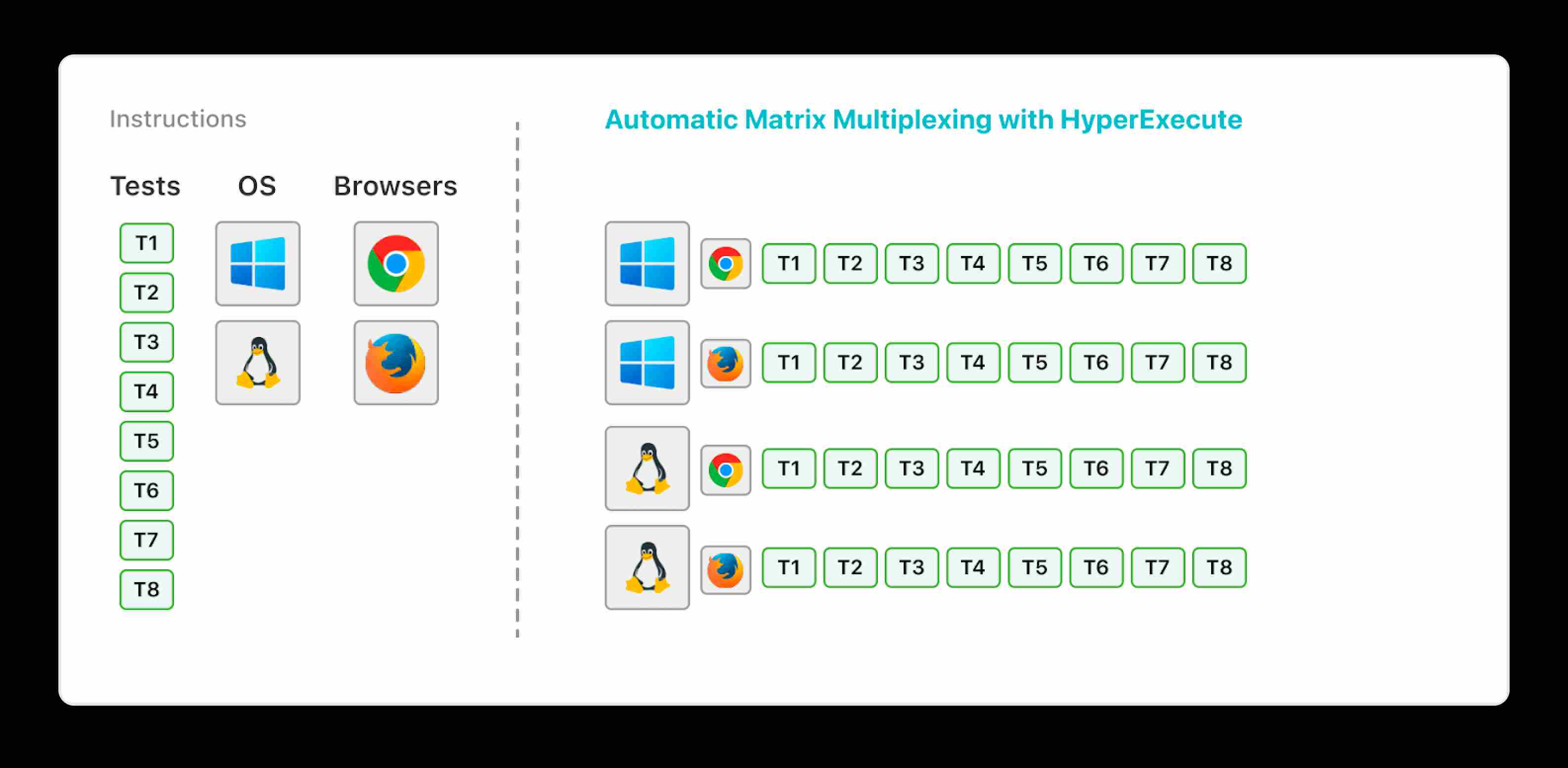Matrix Multiplexing Strategy
HyperExecute's Matrix Multiplexing Strategy allows you to execute test cases across a variety of combinations efficiently. This strategy is especially useful when dealing with browser and OS combinations or other parameters like files, tags, and more.
By utilizing the Matrix Multiplexing Strategy, you can parallelize your testing process and achieve faster results. HyperExecute generates permutations and combinations using key-value pairs, launching virtual machines for each combination and running tests in parallel.

Configuration and Execution
Setting Up Matrix Multiplexing
To initiate Matrix Multiplexing, define key-value pairs in the HyperExecute YAML file. Each pair represents a combination of parameters under consideration, such as browser versions, OS, files, folders, tags, features, scenarios, input values, etc.
Generating and Running Virtual Machines
HyperExecute will generate and manage virtual machines for each key-value combination, injecting them as environment variables or command-line variables. The specified commands will then run for each combination.
Consider a scenario where the matrix calculation results in 10 different possible combinations. In such a case, 10 different Test Execution nodes, known as Tasks will be spawned in parallel and all the tests will be run in parallel on the respective node.
You can use a key as [browser], [files] or any other unique key name.
matrix:
files: ["Test1","Test2","Test3"]
testSuites:
- mvn test -Dtest=$files
In the YAML file shown above, files is a user-generated key. Files and its associated value(s) are opaque to HyperExecute. You can also name it as Files1, FileNames, etc., as long as the Key is unique in that YAML file.
When to opt for Matrix Strategy
Matrix multiplexing strategy is ideally used when you have to run specific test scenarios across different input (or value) combinations. For example, this approach would be useful if you have to run “scenario1” on “N” version(s) of Chrome and Firefox browsers (that are installed on the Windows 10 platform).
Here, ‘N’ could be browser version number(s) that are common between the two web browsers e.g. 68.0, 69.0, 89.0, etc. You can also leverage matrix multiplexing strategy to run scenarios based on different tags, files, features, and more. You can specify required key:value pairs in the HyperExecute YAML file or you can specify the same in the source code.
In matrix multiplexing strategy, key:value pairs mentioned in the source code override the same key:value pairs mentioned in the HyperExecute YAML file.
Let’s modify the above YAML file to run the scenarios on “latest” version of the Firefox browser:
#runson defines the OS of your test execution node.
runson: win
matrix:
# Browser version(s) separated by Comma
version: ["latest"]
# Browser name separated by Comma
browser: ["Chrome", "Firefox"]
# Test Files separated by Comma
files: ["@File1","@File2"]
A combination of test scenarios is generated using the following formula:
Total Test Scenarios = [Entries in os List] x [Entries in browser version List] x [Entries in browser List] x [Entries in Files List]
Let’s take a case where the test scenarios are implemented in Java. Files File1.java and File2. java contains one test method each. In such a scenario, the total number of test combinations would be (1 x 1 x 2 x 2) → 4. Here is the list of the total test scenarios that would be run on HyperExecute (based on the YAML file shown earlier):
| Test Number | FileName | OS | Browser | Browser Version |
|---|---|---|---|---|
| 1 | @File1 (Test Method_1) | Win (Windows 11) | Chrome | latest |
| 2 | @File1 (Test Method_1) | Win (Windows 11) | Firefox | latest |
| 3 | @File2 (Test Method_2) | Win (Windows 11) | Chrome | latest |
| 4 | @File2 (Test Method_2) | Win (Windows 11) | Firefox | latest |
Exclusion in Matrix Strategy
Assuming that you created a matrix but there is one specific combination that you don't want the system to consider. This can happen for instance if you have a combination of Safari and Windows which won't be a valid combination, in such cases you can exclude such a combination using the exclude option as shown below.
#runson defines the OS of your test execution node.
runson: ${matrix.os}
matrix:
# Browser version(s) separated by Comma
version: ["latest"]
# OS name sepataed by Coma
os: [win, mac, linux]
# Browser name separated by Comma
browser: ["Chrome", "Firefox", "brave"]
# Test Files separated by Comma
files: ["@File1","@File2"]
exclude:
# this would exclude the combination of brave browser, linux OS and File2
browser: ["brave"]
files: ["@File2"]
os: [linux]